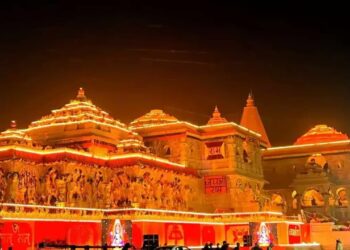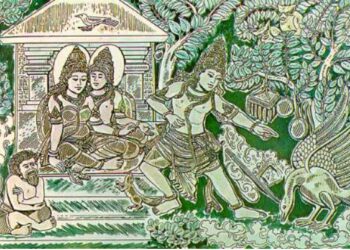In the heart of Ayodhya, amidst the sacred land that cradled the legendary tale of Lord Rama, a symbol of divine devotion and righteousness stands tall – the Ram Mandir. This temple holds a unique and powerful position in the hearts of Hindus and within the vast tapestry of Sanatan Dharma.
Think of the Ram Mandir not as a building, but as a luminous banyan tree, its roots deep in history, its branches reaching towards the future. Each intricate carving tells a story, each polished stone echoes a prayer. This is Sanatan Dharma in all its vibrant glory encapsulating centuries of cultural, spiritual, and historical significance.
Historical Roots
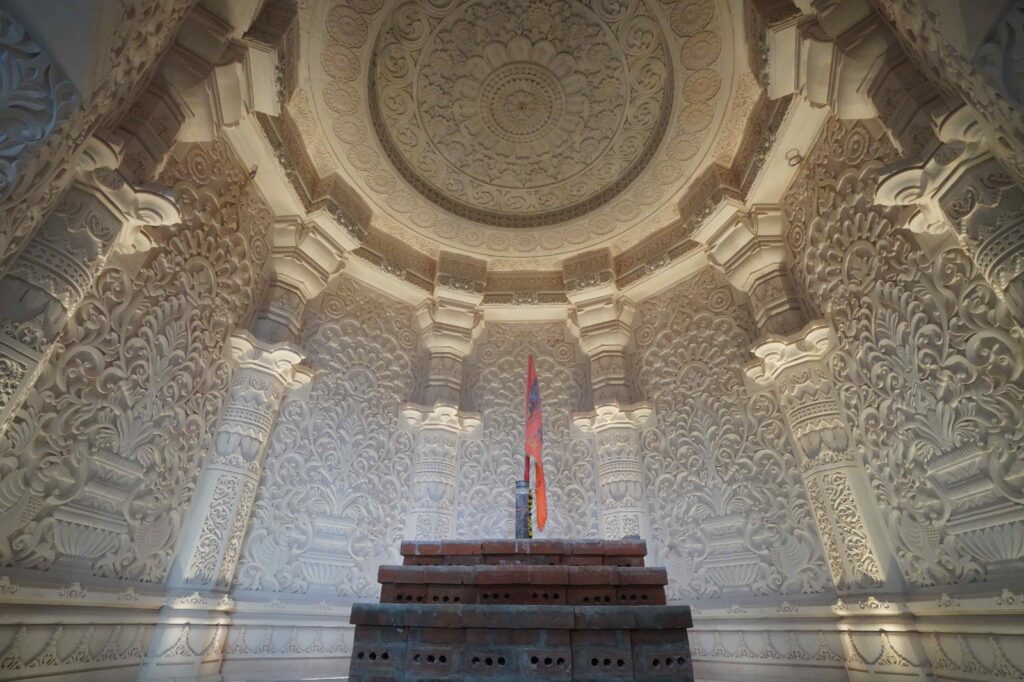
For adherents of Sanatan Dharma, the Ram Mandir is not just a physical structure but a spiritual beacon that radiates the teachings of dharma, righteousness, and devotion. Lord Rama, the seventh avatar of Lord Vishnu, is venerated as the epitome of virtue, and his life serves as a moral compass for millions. The construction of the temple is seen as a homage to the ideals propagated by Lord Rama – values that transcend time and resonate with the core tenets of Sanatan Dharma.
For millions of Hindus, visiting the site is a sacred pilgrimage, a chance to connect with the divine, seek blessings, and immerse oneself in the timeless narratives of Ramayana. The journey to Ayodhya itself, imbued with spiritual significance, becomes a means of inner purification and a strengthening of faith.
The Ram Mandir Movement
The saga of the Ram Janmabhoomi, the birthplace of Lord Rama, has traversed through the annals of history, evoking intense emotions and profound reverence among millions. The proposed grand temple at the previously disputed Ram Janmabhoomi site has been a long-standing dream and demand of many Hindus across India and beyond.
For several centuries, Hindus have believed that a majestic temple dedicated to Rama once stood at the site before being destroyed in the 16th century by Mughal invaders to construct a mosque there, known as Babri Masjid.
The Ram Mandir movement that called for rebuilding the temple gained momentum from the 1980s, as the site was considered among the most sacred places for Hindus. In 2019, the Supreme Court of India delivered a landmark verdict paving the way for a Rama temple at the site. The apex of this movement was reached on August 5, 2020, when the foundation stone for the Ram Mandir was laid by Prime Minister Shri Narendra Modi, culminating in the fulfilment of a longstanding aspiration.
Built to Endure: A Foundation of Fortitude
Ensuring the longevity of the sacred Ram Temple transcends conventional considerations. While the typical lifespan of iron metal is a mere 95 years, the vision for the temple is far-reaching—spanning a millennium. To achieve this, a distinctive stone, renowned for its enduring properties, has been meticulously employed throughout the entire structure, ensuring not just durability, but a timeless legacy. But the story of its resilience begins even deeper, far below the bustling construction.
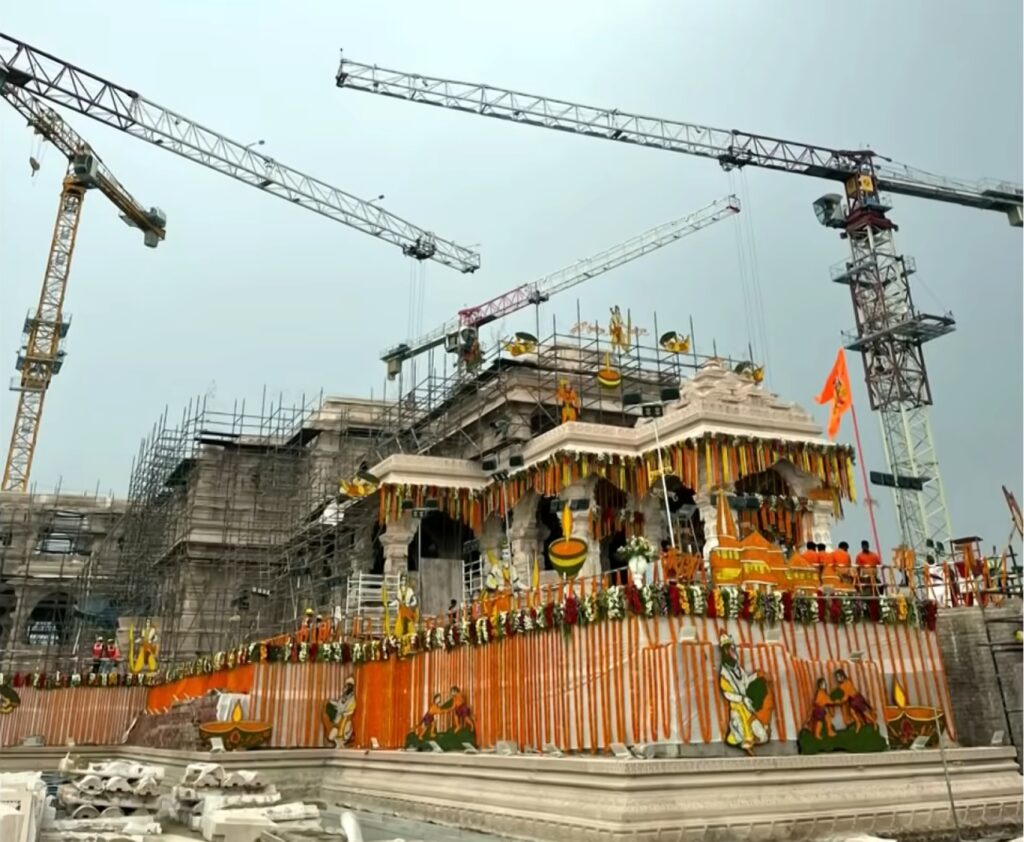
Upon unearthing the Ram Mandir’s foundation, a startling discovery was made. The gentle Sarayu River once flowed through this very spot, leaving behind unstable clay soil. To overcome this hurdle, the temple’s esteemed advisors, IIT Chennai, devised a novel solution. The clay was meticulously removed and replaced with layers of “re-engineered soil” – a marvel of modern engineering. This extraordinary material possesses the remarkable ability to solidify within 14 days, essentially transforming into a stone-like bedrock. With 47 layers laid, reaching a depth of 15 meters, the foundation itself becomes a testament to strength, a solid platform for the divine structure above.
But the story doesn’t end there. Atop this stone base lies a 2.5-meter raft, followed by a 1.5-meter layer of granite slabs, and finally, the temple’s exquisite stonework. This meticulous layering ensures the Ram Mandir can withstand 50 times the force of any earthquake historically recorded in the region. Extensive lab testing and meticulously crafted designs guarantee its ability to weather any storm, both literal and metaphorical.
Finally, to guard against the potential wrath of the Sarayu River, comprehensive flood protection measures have been implemented. Every detail, from the foundation’s depth to the strategic layering of materials, speaks to the unwavering commitment to the Ram Mandir’s longevity.
Soaring with Devotion: Architectural Grandeur
Within the expansive 71-acre complex, the heart of the Ram Mandir beats on a sacred 2.7-acre plot. Here, the divine structure will rise, its majestic form stretching 360 feet long and 235 feet wide, crowned by a 161-foot symphony of shikharas reaching towards the heavens. Inspired by the grandeur of the Gujara-Chalukya style, the main temple, crafted from blushing pink sandstone stands as a bridge between past and present, promising a journey into a world of faith and architectural artistry. 12 imposing gates, each embodying a divine attribute of Lord Rama, stand sentinel, inviting devotees to embark on a transformative journey within.
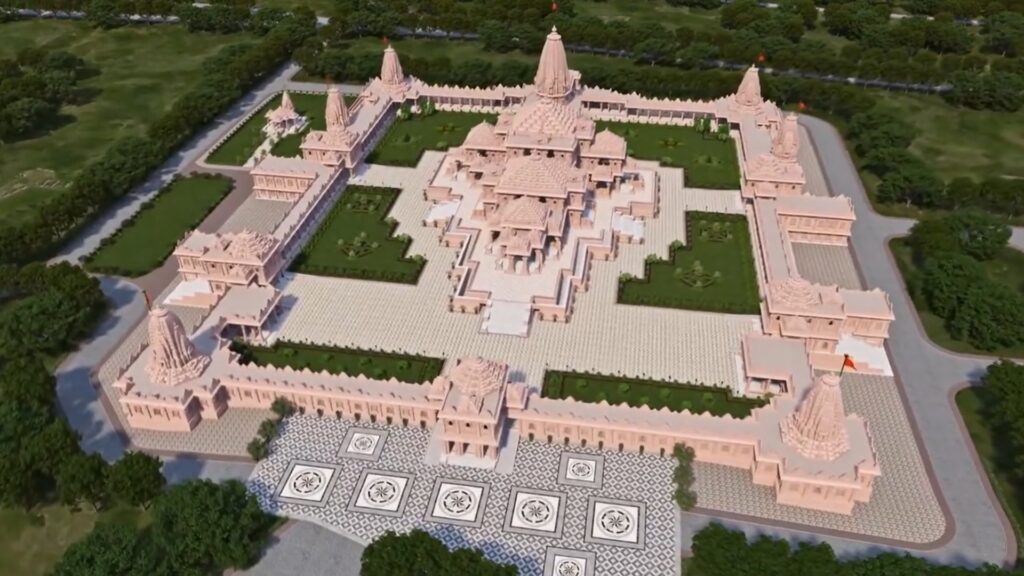
Stepping inside, three floors unfold, each serving a sacred purpose. The ground floor houses the Garbhagriha, a sacred sanctum where the idol of Lord Rama will reside. Ascending to the middle floor, one finds oneself amidst colonnaded mandaps, their ceilings adorned with vibrant murals and pillars sculpted with exquisite detail. The sheer number of pillars – over 390, each intricately carved with multiple statues – is a testament to the dedication of hundreds of skilled artisans.
The saga of Ram, from his birth to coronation, will be intricately etched in stone through a collection of 100 murals on the lower plane. Additionally, a welcoming door (Gopuram) will be constructed, adorned with the emblematic flag of the Suryavanshi lineage, further enhancing the cultural and symbolic richness of the monumental endeavor.
Weaving around the majestic Ram Mandir will be a serene embrace – the Parkota, a corridor offering devotees a tranquil passage to immerse themselves in the temple’s aura. Beyond the sacred boundaries of the Garbha Griha, this corridor promises a journey of reflection and peace.
But the story doesn’t end there. Gazing over the temple from the serene heights of Kuber Teela, a majestic bronze statue of Jatayu, the noble vulture king, stands vigil. Crafted with awe-inspiring detail, at 15 feet tall and 20 feet wide, it serves as a poignant reminder of sacrifice and unwavering loyalty.
And for those seeking solace and rejuvenation after their celestial encounter, the Pilgrimage Destination Centre awaits. This building, situated outside the Parkota yet within the temple complex, offers sanctuary for up to 5000 devotees.
A Divine Journey: Pran Pratishta, the Consecration
The Ram Mandir’s story extends beyond its magnificent stonework. In January, 2024, it will embark on a sacred journey called Pran Pratishta, infusing the divine spirit into the temple’s heart.
The journey begins with the murti, sculpted in Ayodhya itself, receiving a purifying dip in the holy Sarayu River. Then, in a grand procession, Lord Ram, seated on a majestic chariot, will revisit the temples that adorned Ayodhya during his reign. This symbolic homecoming culminates in Ram Lalla entering the Ram Mandir and taking his rightful place in the Garbha Griha, the sanctum sanctorum.
But the magic unfolds as the blindfold placed upon the idol during its journey is finally removed with the chanting of mantras and consecration prayers. This moment, Pran Pratishta, unveils Lord Ram to his devotees, enabling them to witness his divine form in all its grandeur.
While prayers for the existing small idol, known as the Utsav Murti, have continued since 1947, this new Achal Murti, larger and meant to remain within the sanctum, grants devotees the unique privilege of directly gazing upon Lord Ram’s eyes and feet. Both murtis will receive daily prayers and reside together in the Garbha Griha.
On the auspicious day of January 22nd, 2024, only the ground floor with its five mandapas will be complete, welcoming devotees to partake in this historic moment. While the entire temple is expected to be finished by December 2024, the Pran Pratishta marks a monumental step in its journey, infusing the Ram Mandir with the lifeblood of divine presence.
Forged in Unity: A Pan-Indian Legacy
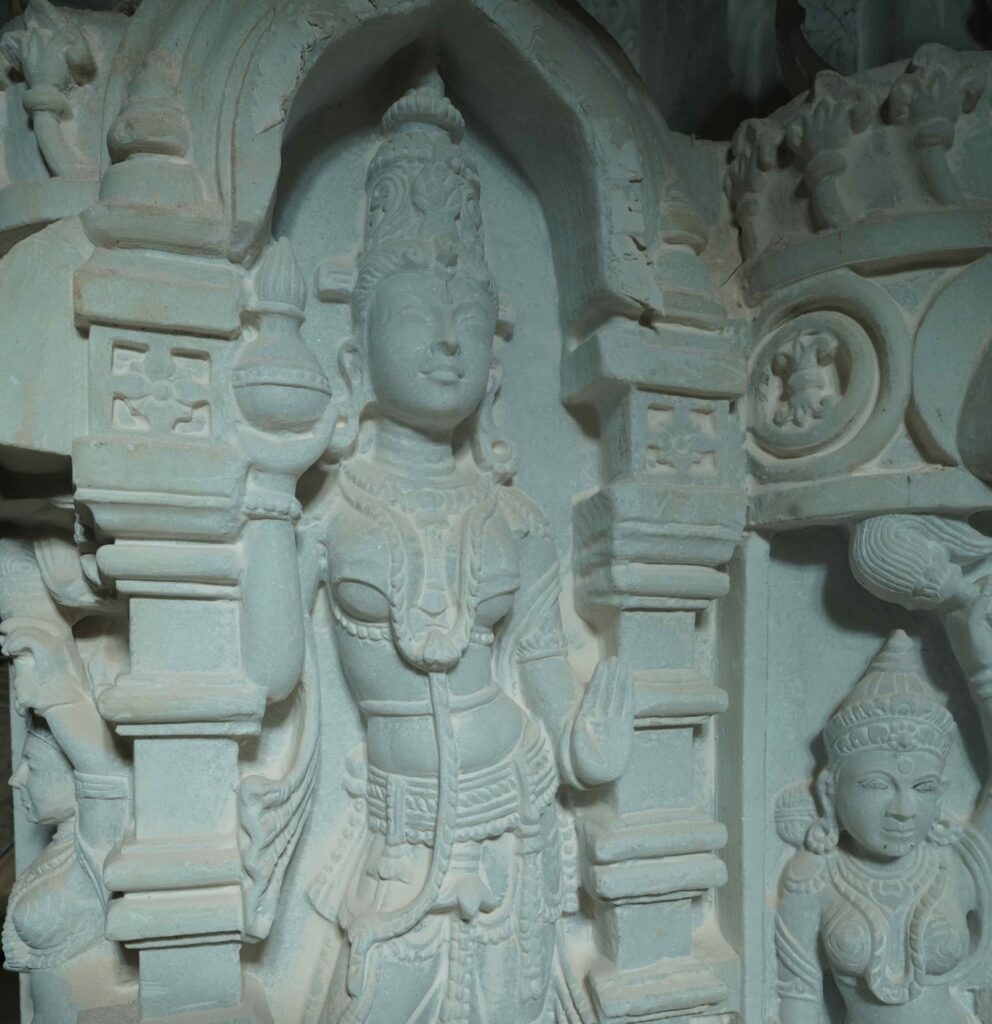
The Ram Mandir stands as a symbol of pan-Indian collaboration. Craftsmen from across the country have poured their talent and devotion into its creation. Skilled artisans from Orissa breathe life into the 30 statues adorning each of the 390 pillars. Rajasthan and Uttar Pradesh’s finest craftsmen utilize copper clips with utmost precision to secure every stone. From Maharashtra and Gujarat, artisans lend their unique talents, ensuring every detail reflects India’s vibrant tapestry.
In a harmonious convergence of craftsmanship and devotion, 42 splendid bells, each weighing between 2 to 2.5 tons, have arrived from the artistry-rich landscapes of Tamil Nadu to the sacred precincts of Ayodhya’s Ram Temple to infuse the temple with an aura of divine resonance.
This collaborative effort extends even to the foundation, where over 4 lakh bricks, each hailing from a different village across India, find their place. In this act of inclusion, every state finds its representation, its contribution etched in the very bones of the temple.
A Global Echo: Celebrating Ram Mandir Across Borders
Lord Ram’s influence transcends borders, resonating with hearts and minds across the globe. The grand Ram Mandir in Ayodhya, a testament to this enduring legacy, will soon unveil its splendor. But its impact extends far beyond the sacred soil of India, sparking celebrations and uniting communities worldwide.
From the vibrant shores of Thailand comes a gesture brimming with cultural significance. Ahead of the Ram Mandir’s inauguration, soil from this ancient land will be sent to Ayodhya, uniting two cultures through this sacred offering. This follows the earlier act of sending water from Thailand’s sacred rivers to Lord Ram’s temple, deepening the spiritual connection between the two nations.
Nepal, too, joins the chorus of celebration with a grand gesture. Two massive Shaligram stones, weighing around 30 and 14-15 tonnes, have been transported from the holy Gandaki riverbank to Ayodhya. These celestial boulders, revered for their auspicious qualities, will be used to craft the divine idols of Ram and Janaki, further embellishing the Ram Mandir with a touch of Himalayan reverence.
Across the United States, temples are gearing up for a week-long extravaganza. From January 15th, a chorus of devotion will rise, culminating on the 22nd with the inauguration of the Ram Mandir in Ayodhya. Over 1100 mandirs, vibrant hubs of faith, are projected to join hands in this monumental celebration, painting America with the hues of Indian culture and religious fervor.
The Ram Mandir project has served as a unifying force, bringing people from diverse backgrounds and communities together. The construction of the temple reflects a collective cultural identity that transcends regional, linguistic, and social boundaries. It stands as a symbol of unity and harmony, reinforcing the inclusive spirit of Sanatan Dharma that embraces all beings.


